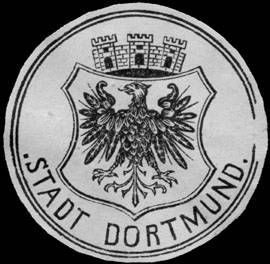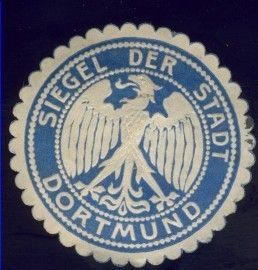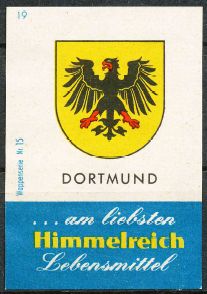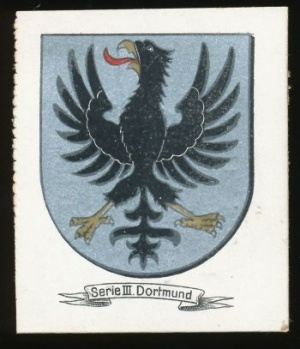Dortmund
This page is part of the German heraldry portal Deutsche Wappensammlung |
Heraldry of the World |
|
German heraldry:
|
Selected collector's items from Germany:
|
DORTMUND
State : Nordrhein-Westfalen
Urban District (Kreisfreie Stadt) : Dortmund
Additioms : 1905 Körne; 1914 Deusen, Dorstfeld, Eving, Huckarde, Kemminghausen, Lindenhorst, Rahm, Wischlingen; 1918 Brackel, Wambel; 1928 Asseln, Bodelschwingh, Bövinghausen, Brechten, Brüninghausen, Derne (partly), Ellinghausen, Grevel, Holthausen, Hörde, Husen, Kirchderne, Kirchlinde, Kley, Kurl, Lanstrop, Lütgendortmund, Marten, Mengede, Nette, Oespel, Westerfilde, Wickede 1929; Aplerbeck, Barop, Berghofen, Kirchhörde, Schüren, Sölde (partly), Somborn (partly), Syburg, Wellinghofen
Official blazon
Origin/meaning
Dortmund is an old city and received city rights in the early 13th century. The city was a free Imperial City and was thus entitled to use the Imperial Eagle in its arms and seals. The oldest great seal of the city, which is known since 1241 shows a city wall with a church or tower behind it. The secret and small seals of the city, however, used only the Imperial Eagle. From these the eagle was placed in the arms. Contrary to the Imperial arms, the field was generally shown as silver.
In 1871 the arms were granted with two lions as supporters and a mural crown. The supporters were again removed in 1888, the crown in 1908. In 1946 the silver field was finally changed to gold, the imperial (but not historical) colour.
| |
Seals from the city from around 1900. |
|
| The arms in the Kaffee Hag albums +/- 1925 |
|
The arms on a 1960s matchox label |
| The arms in the Abadie albums |
The arms in the Continentale Verlags-Anstalt album, +/- 1910 |
The arms in the Abdulla album, 1928 |
Contact and Support
Partners:
Your logo here ?
Contact us
© since 1995, Heraldry of the World, Ralf Hartemink 
Index of the site
Literature : Hupp, O: Kaffee Hag albums, 1920s; Stadler, 1964-1971, 8 volumes.





















